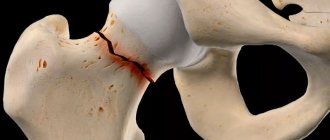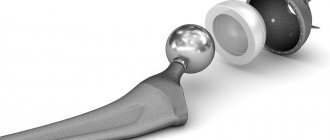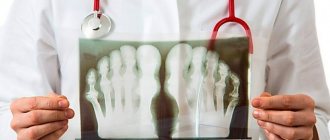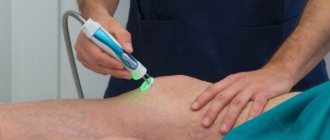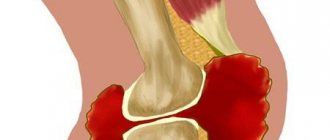Sick joints can significantly reduce the quality of life and deprive the patient of the simple joys of life. To maintain hip health and detect arthritis early, you need to know the symptoms and modern treatment methods. Features of symptoms and treatment depend on the type of arthritis, stage of the disease and provoking factors of the pathology.
Types of inflammation of the hip region
According to the International Classification of Diseases (ICD 10), inflammation of the hip joint is classified as unspecified arthritis under code M13.9, which is divided into the following types:
- Rheumatoid arthritis is an autoimmune inflammatory pathology. The exact causes of the development of the disease have not been established by medicine. However, it has been proven that the process is triggered by abnormal activity of the immune system. Instead of performing a protective function and recognizing harmful viruses and bacteria, the immune system perceives the cells of its own body as enemy cells. Such a deviation triggers an attack of protective immune complexes on organs and bone tissue. Once inside the synovial membrane, immune complexes cause inflammation, increasing the volume of joint fluid. As a result of the inflammatory process, healthy cartilage tissues are destroyed and pathogenic ones grow, which leads to deformation and loss of motor function.
- Psoriatic arthritis - appears mainly as a result of psoriasis, less often - as its predecessor. This type of pathology also has unknown autoimmune and genetic causes. Advanced psoriatic inflammation of the femoral head leads to degeneration of bones and joints, and is also fraught with complications from the central nervous system, diseases of internal organs and complete loss of capacity. Arthritis mutilans is an advanced form of the disease with severe deformation of the limbs.
- Gout is a metabolic type of pathology. The pathological process provokes a complex of metabolic disorders, in which the volume of uric acid in the blood abnormally increases and the kidney function responsible for its removal from the body is impaired. During the synthesis of uric acid, salt deposits are formed in the tissues of organs and joints - urate crystals. Provocateurs of the pathological process are kidney diseases, bad habits, a sedentary lifestyle and lack of a balanced diet. Primary gouty arthritis often occurs due to a hereditary predisposition in adult men. Women suffer from gout quite rarely, more often after menopause.
- Osteoarthritis is the degenerative destruction of cartilage tissue. Arthrosis of the hip joint is not much different in symptoms from arthritis, therefore the definitions “osteoarthrosis” and “osteoarthritis” are synonymous according to the international classification of diseases. The difference is that arthrosis is a degenerative disease of the joints, which in its independent development is not inflammatory. Primary arthrosis is much more common with age and is observed in older people 50-60 years old. Secondary osteoarthritis is provoked by injuries, infections, metabolic disorders and autoimmune pathologies.
- Septic arthritis is an inflammatory disease of the joints caused by pathogenic microflora or viruses entering the synovial membrane. It can have either a direct route of infection through injuries, surgical interventions or punctures with non-sterile instruments, or penetrate from other foci of inflammation. Frequent provocateurs of infectious inflammation are gram-positive cocci, enterobacteria, parasitic strains, herpes viruses, hepatitis, Epstein-Barr and chickenpox.
- Reactive arthritis is a pathology caused by a combination of infectious and autoimmune factors. The main causative agent of infection is infections that enter the body through a secondary route. With reactive inflammation, pathogenic bacteria settle on the surface of the synovial membrane. As a result, a troubled immune system reacts to their presence by sending immune complexes that cause excessive production of pro-inflammatory cytokines within the protective lining of the joint. The joint tissues react to this entire process by developing inflammatory synovitis. Reactive pathology of the hip and arthritis of the lower extremities are most often caused by infectious diseases of the genitourinary system and gastrointestinal tract; in diseases of the upper respiratory tract and ENT organs, the joints of the upper body suffer.
Treatment principle
Treatment of arthrosis-arthritis of the hip joint is prescribed only by a doctor based on examinations
Therapy for joint damage and treatment of arthrosis-arthritis of the hip joint is aimed at:
- restoration of nutrition of cartilage tissue;
- normalization of metabolic processes in the joint;
- reduction of swelling;
- relief of the inflammatory reaction;
- reduction of pain syndrome.
For this purpose, both medicinal and non-medicinal methods are used. Additionally, physiotherapy and massage are prescribed. To restore the motor function of the diseased joint, it is necessary to perform special exercises.
Traditional Treatments
Conservative therapy consists of prescribing the following drugs:
- non-steroidal anti-inflammatory drugs;
- glucocorticosteroids;
- vasodilators;
- chondroprotectors;
- Dietary supplements and vitamins.
Nonsteroidal anti-inflammatory drugs are the first-line drugs of choice for inflammatory joint pathologies accompanied by pain. Medicines in this group relieve inflammation, reduce discomfort, and eliminate symptoms of general malaise, including fever. Usually the drugs Diclofenac, Ibuprofen, Nimesulide are used in any dosage form - ointments, tablets or injections.
Glucocorticosteroids are prescribed for severe inflammation, accompanied by severe swelling. These medications are unsafe and can only be used in a hospital setting. Glucocorticosteroids are administered intra-articularly.
Vasodilator medications are necessary to improve local blood supply. They can be used as a stand-alone remedy or in addition to physical therapy.
Chondroprotectors are a group of drugs that have a positive effect on the condition of cartilage. These medications increase the elasticity of cartilage, improve local metabolic processes and strengthen cartilage tissue.
Dietary supplements are necessary to accelerate the regeneration of the joint and cartilage, vitamins and mineral complexes are used as a prophylactic agent to avoid the progression of the disease.
Physiotherapy
Treatment must be supplemented with physiotherapy. For arthrosis-arthritis the following is prescribed:
- electrophoresis with vasodilators;
- magnetic therapy;
- ultrasound treatment;
- mud therapy;
- phonophoresis.
The choice of the optimal treatment method is made by a doctor. Physiotherapy is prescribed in a course of 10-20 procedures. This treatment is used only after the acute inflammatory process has stopped.
Exercise therapy for arthrosis-arthritis
Performing exercises or therapeutic exercises is an important part of the treatment of arthrosis-arthritis of the hip joint. This allows you to restore normal nutrition to the cartilage and improve the motor function of the diseased joint. A set of exercises will help avoid disability.
Exercise therapy must be performed in a special clinic room, under the supervision of a doctor. The specialist will create an optimal training system.
Simple exercises can be performed at home. They do not require special physical training, so everyone can do them.
- It is comfortable to lie on your stomach with your arms extended along your body. Slowly raise your right leg, hold it in the upper position for a few seconds, and then lower and raise your left leg.
- Lying on your stomach, raise both legs as high as possible and hold in the upper position for 15 seconds.
- Sit on the floor with your legs extended straight in front of you. Smoothly tilt your torso towards your legs without lifting them off the floor, and then slowly straighten up.
All exercises should be performed smoothly, without effort. You should start your workout with five repetitions of each exercise. After a week of daily exercise, the number of repetitions can be increased to 10.
Folk remedies
Traditional medicine methods will help speed up recovery. At home, it is allowed to use warming, salt compresses, and lotions with alcohol tincture of propolis. Additionally, you can take drugs to strengthen the immune system and anti-inflammatory decoctions.
Folk remedies can only be used in addition to conservative treatment methods.
Clinical picture of the disease
Inflammatory and degenerative types of hip joint pathology have common symptoms:
- Pain syndrome. Joint pain intensifies when walking and can radiate to the groin, buttocks, back and legs.
- Muscle stiffness when staying in one position for a long time.
- Tingling in the limbs, back, groin and buttocks.
- Swelling, redness and local increase in skin temperature, sensation of hot areas of the skin when palpated.
- Limping when walking and limited range of motion of the hip bones.
Depending on the type of arthritis, symptoms and features of their manifestation characteristic of various types of inflammation are added to the general signs.
Thus, with rheumatoid arthritis of the hip joint, there is stiffness of movement and numbness in the area of inflammation in the morning. Even before the onset of pain, fatigue, loss of appetite, sleep disturbances, and throbbing in the limbs may be present. Inflammation in this type of pathology progresses gradually - the first signs are mild, the symptoms intensify as the pathology develops.
The psoriatic type of inflammation has the characteristic features inherent in psoriasis - a purplish-blue tint of the skin, and the possible appearance of rashes and plaques. In autoimmune pathology, atrophy of the affected joints occurs.
A gout attack begins with a sudden sharp pain and burning sensation at the site of the lesion. The exacerbation lasts from several hours to 2-3 days, then passes without a trace. In the initial stages, the period of calm can last about a month, and then also sharply worsen. With the development of inflammation, these intervals decrease significantly. Another specific sign of gouty arthritis is the appearance of subcutaneous granulomas. Tophi nodules appear as a result of a large accumulation of salt deposits of uric acid in the area of inflammation.
With septic and reactive arthritis, painful symptoms also do not keep you waiting. After direct infection, pain appears within a few days, and with a reactive factor, it takes no more than a month after infection. Infectious inflammation is accompanied by signs of fever: elevated body temperature, chills, nausea and vomiting. The joint suddenly swells greatly and the skin turns red. In an advanced state, purulent arthritis develops.
Primary osteoarthritis and arthrosis arthritis of the hip joint combines general symptoms of the disease and rheumatic symptoms. The pain intensifies when standing or walking. The range of actions is limited - it is especially difficult to bend and straighten the joint. With the secondary manifestation of osteoarthritis, signs characteristic of the provoking cause of inflammation appear.
What is arthrosis-arthritis?
Osteoarthritis affects the cartilage tissue of the joints
Arthrosis-arthritis is a disease that affects both the joint and cartilage tissue. The disease is characterized by the symptoms, causes of development and clinical course of two diseases at once - arthritis and arthrosis.
Arthritis is inflammation of the joint capsule. The pathology may be associated with early injuries, infectious diseases, and autoimmune disorders. Arthritis is often a consequence of gout or psoriasis. The pathology manifests itself at any age and is associated with the functioning of the immune system, since inflammation in the joint begins due to the release of specific antibodies that cause a reaction.
Arthrosis is a degenerative disease that affects the cartilaginous layer located at the junction of bones. This layer plays a vital role - it ensures normal mobility of the joint, cushions the joint when walking, and protects the bones from friction. The main reasons for the development of arthrosis are heavy loads, a sedentary lifestyle, excess weight, and malnutrition of the cartilage due to injuries.
If arthritis is diagnosed in people of all age categories, arthrosis is more typical for older patients, since one of the factors in its development is the natural wear and tear of cartilage tissue.
Both diseases are characterized by pain and impaired mobility of the affected joint.
Osteoarthritis of the hip joint is a fairly common disease. The average age of patients is 50 years and older. Women are more likely to experience pathology than men due to their metabolism, which slows down after menopause.
Damage to the hip joint is associated with increased load on this joint. In the human body, the most vulnerable joints that take part in movement are the hip, knee and ankle joints.
Disease development process
The severity of symptoms of all types of arthritis depends on the degree of inflammation and destruction of healthy cartilage tissue.
In total, there are 3 stages of the pathogenic process:
- The first stage in most cases is practically asymptomatic. Alarm bells may include morning stiffness and numbness in the hip area, as well as tingling in the groin and legs and mild discomfort. Minor flares of pain may appear during physical activity and pass quickly.
- Arthritis of the hip joint grade 2 is more pronounced. Pain appears during movements and in a standing position, when body weight presses on the joint. At this stage, you can notice specific changes in the color and temperature of the skin, as well as swelling and induration. Degenerative changes begin to develop.
- At the last stage of the disease, complete deformation and loss of functionality occurs. It becomes almost impossible to move, complications develop.
All types of inflammation have three degrees of development, the only difference is that different amounts of time can pass between them:
- With infectious arthritis, the first stage is completely asymptomatic and the disease immediately manifests itself with severe pain.
- With gout, initial symptoms may also be absent, and the chronic form develops soon after the first exacerbation.
- Psoriatic, rheumatoid arthritis and osteoarthritis have blurred primary symptoms and can develop slowly in the initial stages and then progress rapidly.
Causes and provoking factors for the development of the disease
The presence of chronic diseases can cause arthrosis-arthritis of the hip joint
The main causes of arthrosis-arthritis of the hip joint:
- natural wear and tear of cartilage tissue;
- excess body weight;
- poor posture, flat feet;
- congenital anomalies of the structure of the musculoskeletal system;
- severe viral and infectious diseases;
- injuries and hypothermia of the joint;
- decreased immunity;
- metabolic disease;
- poor circulation in the lower body;
- chronic diseases.
The cartilage tissue of the hip joint wears out quickly, so about a third of people over the age of 60 experience some form of dysfunction. One of the most common factors leading to the development of the disease is excess weight. If you are overweight, the spine experiences severe stress during movement. This leads to increased load on the hip joint and increases the rate of wear of cartilage tissue. Because of this, blood circulation in the pelvic area and lower extremities is also impaired. The consequence is a malnutrition of the cartilage, its gradual thinning and destruction.
The inflammatory process characteristic of arthritis develops against the background of decreased immunity. If a person has recently had an infectious disease, the risk of developing arthritis increases. Also, in the presence of a chronic source of infection in the body, there is a risk of spread of pathogenic agents through the bloodstream and infection of the joint. Severe hypothermia can lead to the development of inflammation.
Joint injuries, bruises, fractures and other injuries are one of the factors in the development of arthritis. An accidental fall and bruise of the hip joint can cause the onset of an inflammatory process. Due to the structural features of this joint, arthritis and arthrosis often develop simultaneously, since injuries to the hip joint also lead to disruption of local blood circulation, as a result of which the cartilage does not receive additional nutrients.
The risk group for developing the disease includes people over 50 years of age and professional athletes.
Chronic diseases, such as diabetes, gout, psoriasis, systemic lupus erythematosus, scleroderma, are accompanied by circulatory disorders and changes in the functioning of the immune system. All this can lead to the development of problems of the musculoskeletal system, including arthrosis-arthritis of the hip joint.
As you can see, there are many factors that provoke the development of the disease. These also include intoxication of the body, chronic infectious diseases and even bad habits that impair metabolism and blood circulation.
Need for medical attention
The sooner the first signs of the disease are noticed, the more effective the treatment of the pathology will be. An examination is necessary if you notice the following symptoms:
- Having woken up, it is difficult to immediately get out of bed due to stiffness and numbness in the hip area.
- Feel sudden pain in your hip that radiates to your groin, buttocks, or legs.
- Joint mobility decreases after being in one position for a long time.
- I began to experience sudden pain attacks and aches in the bones, which quickly passed.
- The pain appeared after some illness, bruises, or surgery.
- You have recently been very cold or your work activity involves heavy loads on your joints.
- Joint pathologies occurred in relatives.
- Recently you have been exposed to constant stress, as a result of which you sleep poorly, have eating disorders and experience general weakness.
- There is excess weight, a tendency to overeat and bad habits.
To establish an accurate diagnosis and cause of hip arthritis, you need to consult a rheumatologist.
Diagnostic measures will include personal and family history, examination of the injured joint, laboratory tests of blood, urine, puncture of synovial fluid, x-rays, CT and MRI. If there is a suspicion of gout, an ultrasound of the kidneys is also necessary. The diagnostic results will help to distinguish the type of inflammatory pathology and methods of effective therapy.
Drug treatment
Any exacerbation of arthritis requires the use of medications. The main objectives of medications are to relieve inflammation and eliminate or suppress the cause of the pathogenic process.
For the first purpose, non-steroidal anti-inflammatory drugs (NSAIDs) and analgesics are prescribed. They help relieve pain, relieve swelling and temporarily improve the patient’s general condition. In addition to tablets and injections, ointments and gels with an anesthetic effect are used.
